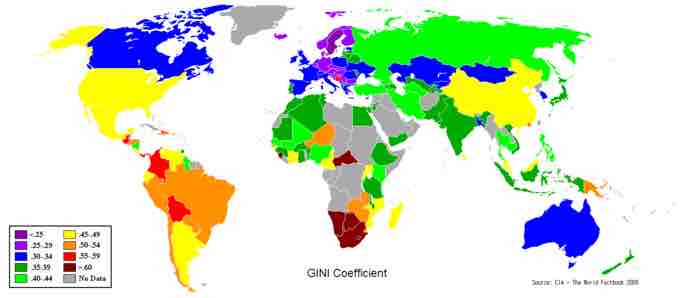Economic inequality (also known as the gap between rich and poor, income inequality, wealth disparity, or wealth and income differences) consists of disparities in the distribution of wealth (accumulated assets) and income. The term typically refers to inequality among individuals and groups within a society, but can also refer to inequality among countries. The issue of economic inequality is related to the ideas of equity: equality of outcome and equality of opportunity. There are various numerical indices for measuring economic inequality, but the most commonly used measure for the purposes of comparison is the Gini coefficient (also known as the Gini index or Gini ratio for Italian statistician and sociologist Corrado Gini). The Gini coefficient is a statistical measure of the dispersal of wealth or income. A Gini coefficient of zero indicates that there is perfect equality—assets are equally divided between all people in the group. A Gini coefficient of one indicates that all of a group's wealth is held by one individual. Most countries fall toward the middle of this range .

Map of Global Gini Coefficients
Using Gini coefficients, this map illustrates the extent to which each country in the world has internal inequality, or a gap between its richest and poorest citizens.
There are many reasons for economic inequality within societies, and they are often interrelated. Acknowledged factors that impact economic inequality include, but are not limited to:
- Inequality in wages and salaries;
- The income gap between highly skilled workers and low-skilled or no-skills workers;
- Wealth concentration in the hands of a few individuals or institutions;
- Labor markets;
- Globalization;
- Technological changes;
- Policy reforms;
- Taxes;
- Education;
- Computerization and growing technology;
- Racism;
- Gender;
- Culture;
- Innate ability
A major cause of economic inequality within modern economies is the determination of wages by the capitalist market. In the capitalist market, the wages for jobs are set by supply and demand. If there are many workers willing to do a job for a great amount of time, there is a high supply of labor for that job. If few people need that job done, there is low demand for that type of labor. When there is high supply and low demand for a job, it results in a low wage. Conversely, if there is low supply and high demand (as with particular highly skilled jobs), it will result in a high wage. The gap in wages produces inequality between different types of workers.
Apart from market-driven factors that affect wage inequality, government sponsored initiatives can also increase or decrease inequality. Social scientists and policy makers debate the relative merits and effectiveness of each approach to regulating inequality. Typical government initiatives to reduce economic inequality include:
- Public education: Increasing the supply of skilled labor and reducing income inequality due to education differentials.
- Progressive taxation: The rich are taxed proportionally more than the poor, reducing the amount of income inequality in society.
- Minimum wage legislation: Raising the income of the poorest workers
- Nationalization or subsidization of products: Providing goods and services that everyone needs cheaply or freely (such as food, healthcare, and housing), governments can effectively raise the purchasing power of the poorer members of society.